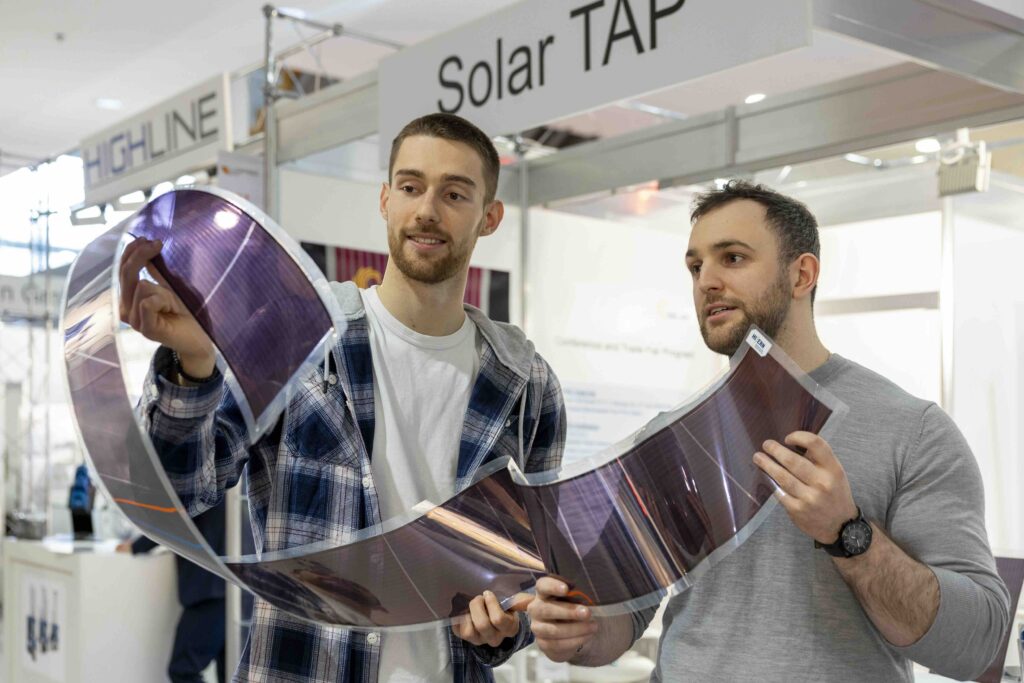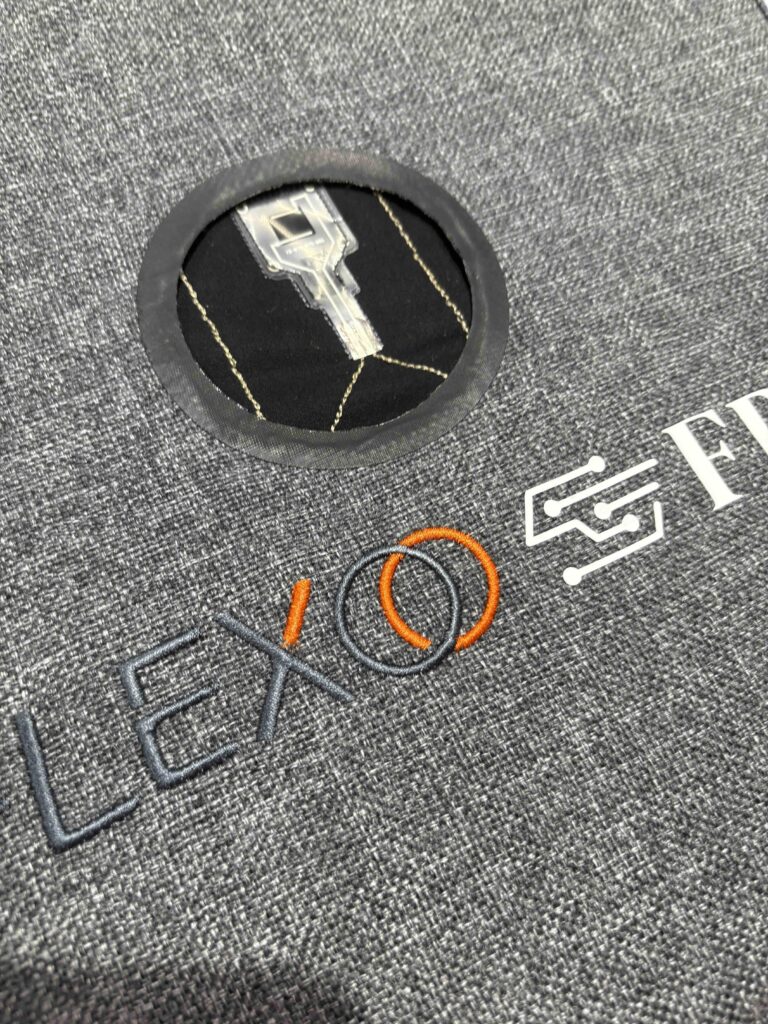
Energy has become a key issue in the development of e-textiles for applications ranging from wearables to transport. LOPEC 2025, held in Munich in February, elected to highlight the end-user perspective this year across conference papers, poster presentations and the Innovation Showcase, with new technologies sharing the stage with energy efficient designs, so that every aspect might be considered.
This ranged from ultra-thin, highly flexible, small-format solar cell films to more computationally efficient Artificial Intelligence (AI) and brain-inspired architectures developed so that data might be processed locally and more sustainably. As the electronics component of e-textiles are becoming more discreet, flexible and integrated, it is hardly surprising that markets should turn their attention to the power supply.
Silent speech interfaces
In his paper titled “AI-driven wearable Tech and neuromorphic sensors: advancing sustainable smart edge devices,” Prof. Luigi G. Occhipinti discussed his University of Cambridge research group’s advances in medical wearables, as well as their energy demand. Specifically, silent speech interfaces were discussed, which are cutting edge solutions for scenarios where verbal communication is hindered.
Medically this can include conditions such as stroke, cerebral palsy, Parkinson’s disease or patient recovery from laryngeal surgeries, with other applications envisaged in addressing sleep apnea, or for general sleep disorders where continuous monitoring is required. In Occhipinti’s work, an ultra-sensitive strain sensor is embedded into a smart choker wearable that conforms to the user’s throat. The strain-sensing mechanism uses a few-layer graphene (FLG) to achieve high accuracy, high computational efficiency and fast decoding speed that affords both time and energy saving.
The device offers user comfort, without the need to reduce sensory channels that can result in less detailed data capture, reducing the accuracy in speech decoding. The ultra-sensitivity allows for the capture of subtle throat movements, and this simplifies the signal processing and allows for the use of a computationally efficient neural network that reduces the computational load by up to 90 percent.
The novelty of the wearable is the choker’s unique structure that features ordered through-cracks on graphene-coated bamboo/elastane textile to significantly enhance sensitivity and increase the quality and quantity of data collected.

Batteries and charging
Batteries can present problems with overheating, overcharging, uneven charging and an unpredictable lifespan. Provider of printed electronics and sensors FLEXOO, headquartered in Heidelberg, Germany, is addressing this issue with its MiniMoS software and battery monitoring system, which allows for the measurement of vital parameters of a battery pack at the cell level. Using ultra-thin printed sensors that offer pressure and temperature measurements via Bluetooth in real time, the system allows for the targeted replacement of defective cells and in this way helps to prevent stress on batteries that can cause premature aging.
As printed electronics, the MiniMoS offers a space-saving solution that can be easily integrated into the battery production process. It offers market gains in terms of reliability and direct cost savings in industries such as electric vehicles (EVs), where the cost of batteries can account for more than a third of the purchase price. The company is also collaborating with the textile industry, showcasing a joint project with FRTI, the Swiss specialists in conductive embroidery (e-broidery). FRTI is an independent business unit of Inter-Spitzen AG within the Forster group with a history of sensing, lighting and heating e-textiles for medical, wearables and other applications.
Tapping into solar
Solar Tap is a technology acceleration platform for emerging photovoltaics, particularly organic photovoltaics (OPV) and perovskites. The initiative, directed at the transfer of technology from laboratory to industry, has come from the Helmholtz Institute Erlangen-Nuremberg for Renewable Energy. Central to this is establishing a network that covers the entire value chain. The solar factory, while operated as a research facility, also supports the technology transfer process working with industry partners using a “lab-to-fab” approach.
Printed thin-film PVs are being produced on flexible substrates achieving a low power-to-weight ratio with different colors that can be adapted for specific market applications. The substrate and packaging accounts for 99 percent of the materials used, and these can be recycled, with further environmental gains achieved through the production process with low energy input and little chemical waste. Market needs are incorporated at an early stage in the development process so that the risk for industry is reduced.
Energy autonomy
Prof. Matti Mäntysalo discussed the work of the Laboratory for Future Electronics (LFE), Tampere University, Finland, and international partners on energy-autonomous sensors, exploring solutions for storage and harvesting that have the potential to redefine how electronics, including e-textiles, power them. LFE is coordinator of the Finnish National Printed Intelligence Infrastructure (PII) focused on future electronics that includes low-power components and circuits, on-skin sensors and soft platforms.
One field of study is Activated Wood Carbon (AWC). This is derived from biomass and offers a sustainable alternative to conventional activated carbon for advanced printed supercapacitors. These have an important role to play in energy storage. A number of biomass carbon sources have been used in the development of electrode materials for supercapacitors including waste coffee beans, nutshells, wood and its waste.
In his presentation, Mäntysalo used the example of alder wood charcoal, processed to enhance its porosity and surface area, combined with sodium hydroxide (NaOH). It has the potential to play an important role in electrochemical energy storage with its ability to cover a large surface area, chemical resistance, very good electrical conductivity and its light weight.
The French company, BeFC are pioneers in biofuel cell technology and have developed a paper-based battery that is metal-free and compostable. It uses enzymes to convert sugar molecules (for example, glucose) and oxygen into electricity. Bringing these paper-based batteries together with circuit boards has the potential to offer some new possibilities for sustainable energy harvesting and green electronics. Temperature, humidity and other forms of data collection are possible, with communication supported with Bluetooth or NFC technologies.
At end-of-life the current iteration is designed for industrial composting. With an estimated 15 billion batteries disposed of each year, and 97 percent of these going to landfill or being incinerated, the technology is a promising contribution to green electronics and e-textiles.
Dr. Marie O’Mahony is an academic, industry consultant and the author of several books on advanced and smart textiles published by Thames and Hudson. She is a regular contributor to Textile Technology Source.
 TEXTILES.ORG
TEXTILES.ORG


